MGT723 Research Project: Organizational Behavior & Carbon Emission
VerifiedAdded on 2023/06/12
|11
|1864
|368
Report
AI Summary
This research paper investigates the impact of organizational behavior related to climate change on carbon emissions, using data collected from 60 firms across India, South Africa, and Brazil. Descriptive statistics reveal a high variation in CO2 emissions among firms, with an average emission of 130927619401 and an average change of 9.5%. Analysis of categorical variables indicates that boards have the highest level of direct responsibility for carbon emission in 90% of the firms, and 80% of firms incentivize managers to reduce carbon emissions. Inferential statistics, including chi-square tests, show no significant difference in emission changes based on the authority responsible for carbon emission. Correlation analysis suggests a negative relationship between the dependent variable and factors like incentives for managers and integration of climate change into business strategy. Regression analysis indicates that the independent variables explain less than 1% of the variation in carbon emissions, with no statistically significant coefficients.
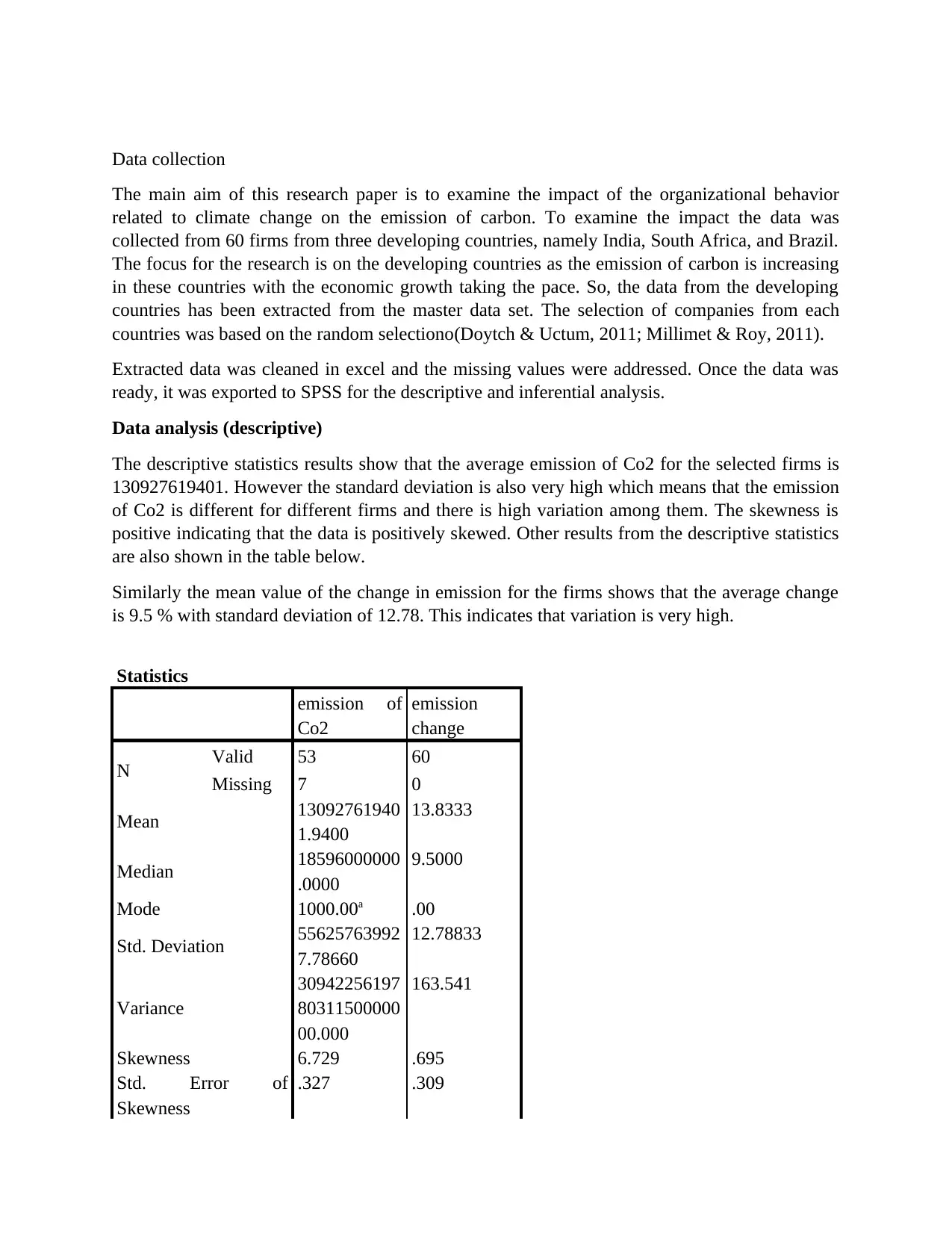
Data collection
The main aim of this research paper is to examine the impact of the organizational behavior
related to climate change on the emission of carbon. To examine the impact the data was
collected from 60 firms from three developing countries, namely India, South Africa, and Brazil.
The focus for the research is on the developing countries as the emission of carbon is increasing
in these countries with the economic growth taking the pace. So, the data from the developing
countries has been extracted from the master data set. The selection of companies from each
countries was based on the random selectiono(Doytch & Uctum, 2011; Millimet & Roy, 2011).
Extracted data was cleaned in excel and the missing values were addressed. Once the data was
ready, it was exported to SPSS for the descriptive and inferential analysis.
Data analysis (descriptive)
The descriptive statistics results show that the average emission of Co2 for the selected firms is
130927619401. However the standard deviation is also very high which means that the emission
of Co2 is different for different firms and there is high variation among them. The skewness is
positive indicating that the data is positively skewed. Other results from the descriptive statistics
are also shown in the table below.
Similarly the mean value of the change in emission for the firms shows that the average change
is 9.5 % with standard deviation of 12.78. This indicates that variation is very high.
Statistics
emission of
Co2
emission
change
N Valid 53 60
Missing 7 0
Mean 13092761940
1.9400
13.8333
Median 18596000000
.0000
9.5000
Mode 1000.00a .00
Std. Deviation 55625763992
7.78660
12.78833
Variance
30942256197
80311500000
00.000
163.541
Skewness 6.729 .695
Std. Error of
Skewness
.327 .309
The main aim of this research paper is to examine the impact of the organizational behavior
related to climate change on the emission of carbon. To examine the impact the data was
collected from 60 firms from three developing countries, namely India, South Africa, and Brazil.
The focus for the research is on the developing countries as the emission of carbon is increasing
in these countries with the economic growth taking the pace. So, the data from the developing
countries has been extracted from the master data set. The selection of companies from each
countries was based on the random selectiono(Doytch & Uctum, 2011; Millimet & Roy, 2011).
Extracted data was cleaned in excel and the missing values were addressed. Once the data was
ready, it was exported to SPSS for the descriptive and inferential analysis.
Data analysis (descriptive)
The descriptive statistics results show that the average emission of Co2 for the selected firms is
130927619401. However the standard deviation is also very high which means that the emission
of Co2 is different for different firms and there is high variation among them. The skewness is
positive indicating that the data is positively skewed. Other results from the descriptive statistics
are also shown in the table below.
Similarly the mean value of the change in emission for the firms shows that the average change
is 9.5 % with standard deviation of 12.78. This indicates that variation is very high.
Statistics
emission of
Co2
emission
change
N Valid 53 60
Missing 7 0
Mean 13092761940
1.9400
13.8333
Median 18596000000
.0000
9.5000
Mode 1000.00a .00
Std. Deviation 55625763992
7.78660
12.78833
Variance
30942256197
80311500000
00.000
163.541
Skewness 6.729 .695
Std. Error of
Skewness
.327 .309
Paraphrase This Document
Need a fresh take? Get an instant paraphrase of this document with our AI Paraphraser
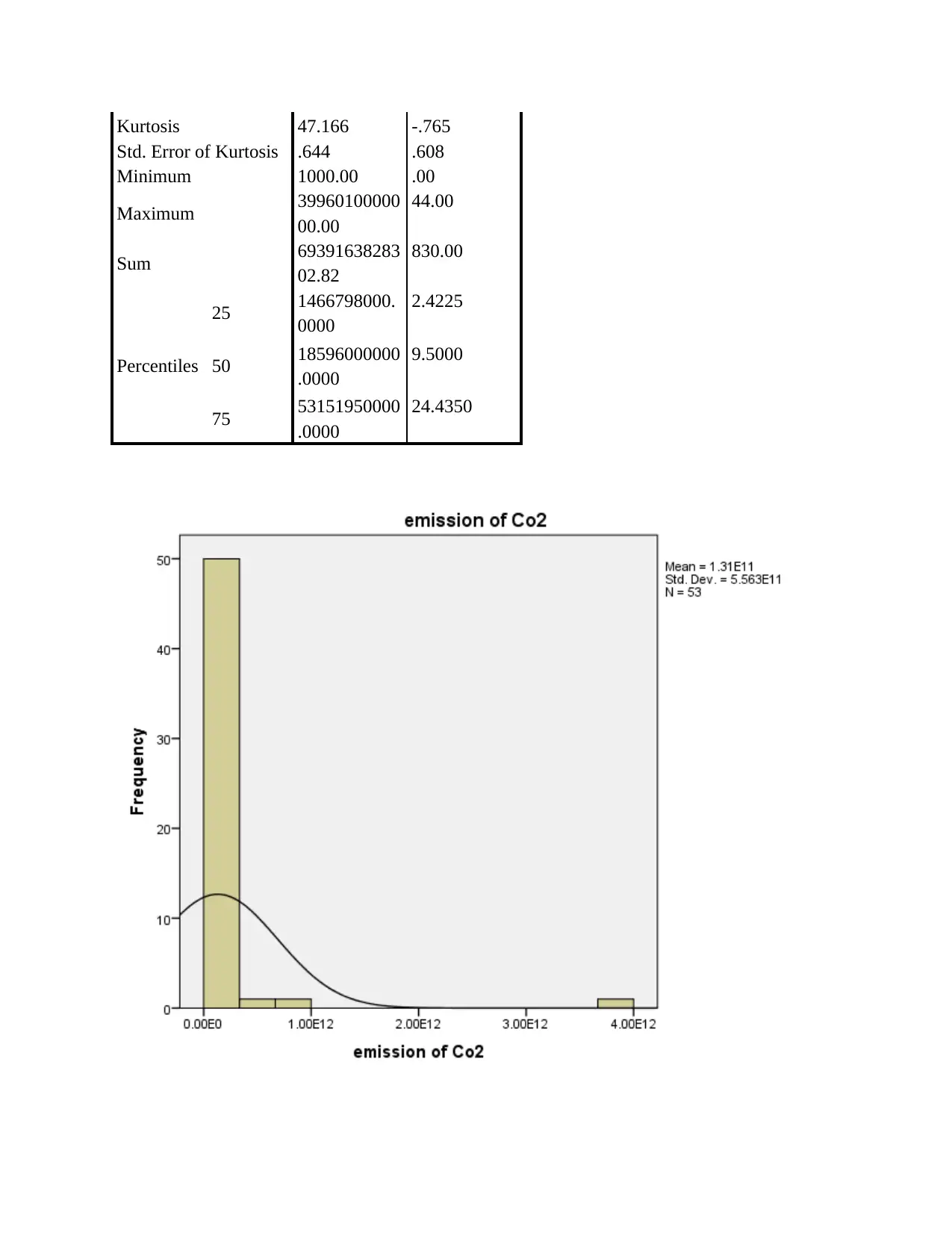
Kurtosis 47.166 -.765
Std. Error of Kurtosis .644 .608
Minimum 1000.00 .00
Maximum 39960100000
00.00
44.00
Sum 69391638283
02.82
830.00
Percentiles
25 1466798000.
0000
2.4225
50 18596000000
.0000
9.5000
75 53151950000
.0000
24.4350
Std. Error of Kurtosis .644 .608
Minimum 1000.00 .00
Maximum 39960100000
00.00
44.00
Sum 69391638283
02.82
830.00
Percentiles
25 1466798000.
0000
2.4225
50 18596000000
.0000
9.5000
75 53151950000
.0000
24.4350
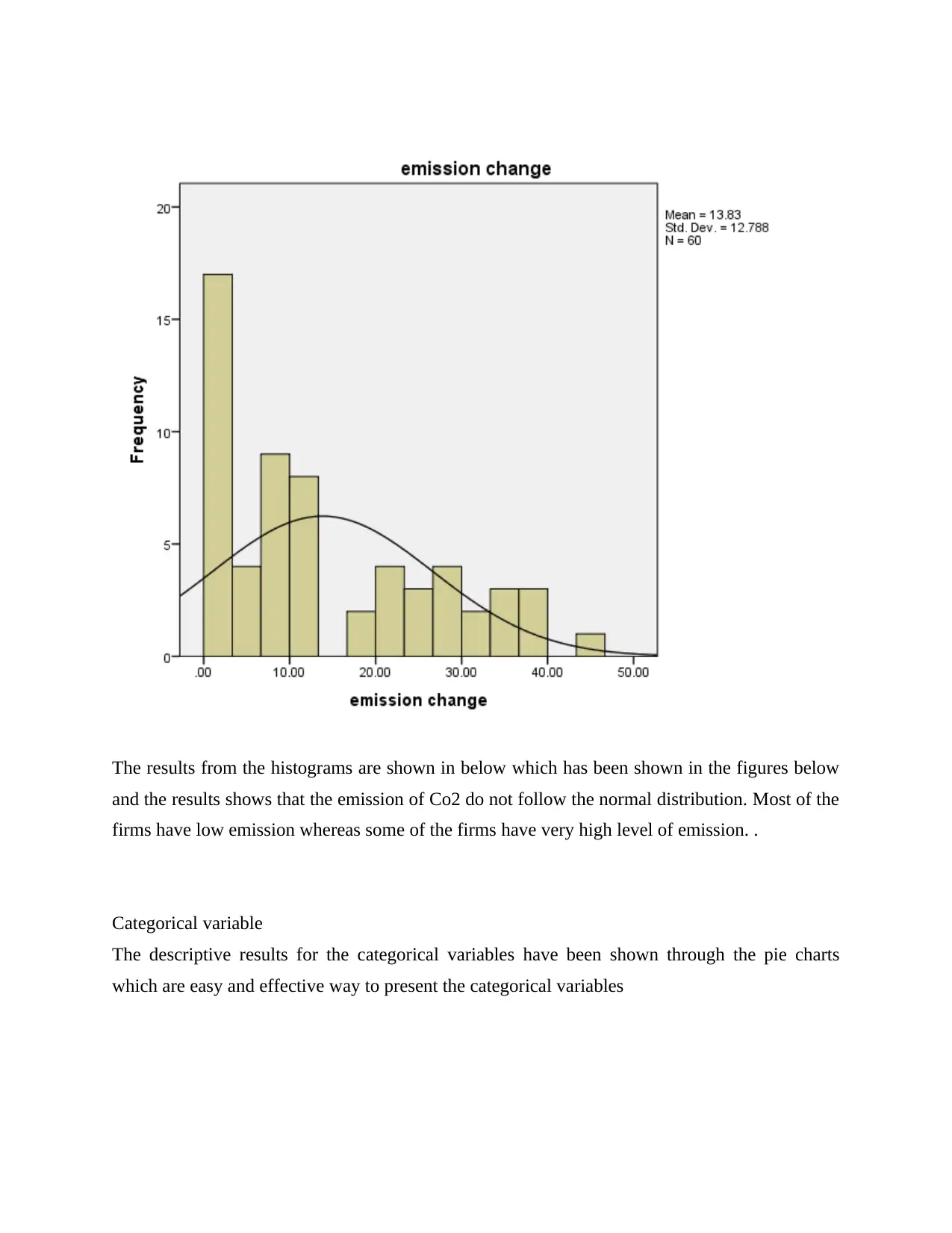
The results from the histograms are shown in below which has been shown in the figures below
and the results shows that the emission of Co2 do not follow the normal distribution. Most of the
firms have low emission whereas some of the firms have very high level of emission. .
Categorical variable
The descriptive results for the categorical variables have been shown through the pie charts
which are easy and effective way to present the categorical variables
and the results shows that the emission of Co2 do not follow the normal distribution. Most of the
firms have low emission whereas some of the firms have very high level of emission. .
Categorical variable
The descriptive results for the categorical variables have been shown through the pie charts
which are easy and effective way to present the categorical variables
⊘ This is a preview!⊘
Do you want full access?
Subscribe today to unlock all pages.

Trusted by 1+ million students worldwide
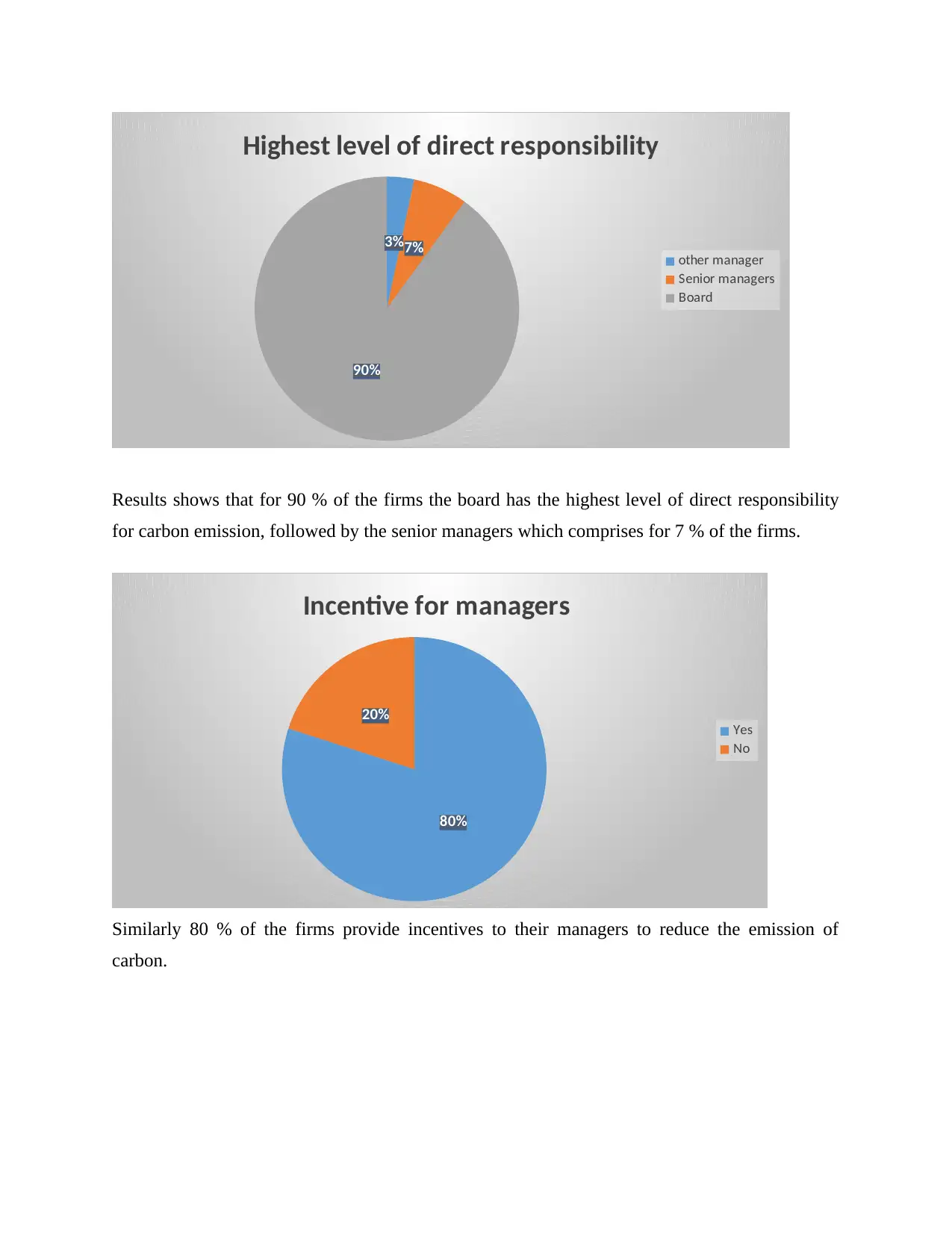
3%7%
90%
Highest level of direct responsibility
other manager
Senior managers
Board
Results shows that for 90 % of the firms the board has the highest level of direct responsibility
for carbon emission, followed by the senior managers which comprises for 7 % of the firms.
80%
20%
Incentive for managers
Yes
No
Similarly 80 % of the firms provide incentives to their managers to reduce the emission of
carbon.
90%
Highest level of direct responsibility
other manager
Senior managers
Board
Results shows that for 90 % of the firms the board has the highest level of direct responsibility
for carbon emission, followed by the senior managers which comprises for 7 % of the firms.
80%
20%
Incentive for managers
Yes
No
Similarly 80 % of the firms provide incentives to their managers to reduce the emission of
carbon.
Paraphrase This Document
Need a fresh take? Get an instant paraphrase of this document with our AI Paraphraser
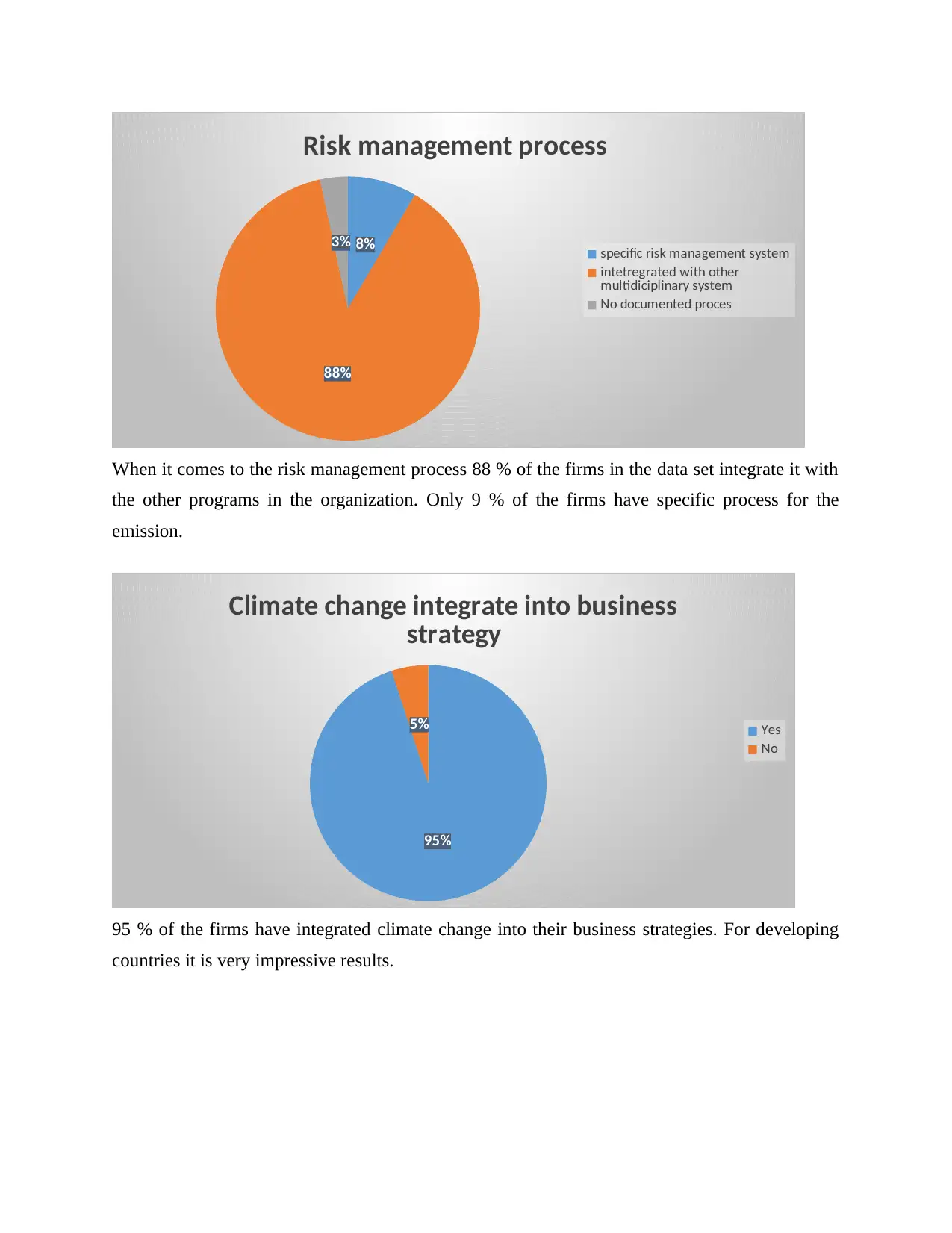
8%
88%
3%
Risk management process
specific risk management system
intetregrated with other
multidiciplinary system
No documented proces
When it comes to the risk management process 88 % of the firms in the data set integrate it with
the other programs in the organization. Only 9 % of the firms have specific process for the
emission.
95%
5%
Climate change integrate into business
strategy
Yes
No
95 % of the firms have integrated climate change into their business strategies. For developing
countries it is very impressive results.
88%
3%
Risk management process
specific risk management system
intetregrated with other
multidiciplinary system
No documented proces
When it comes to the risk management process 88 % of the firms in the data set integrate it with
the other programs in the organization. Only 9 % of the firms have specific process for the
emission.
95%
5%
Climate change integrate into business
strategy
Yes
No
95 % of the firms have integrated climate change into their business strategies. For developing
countries it is very impressive results.
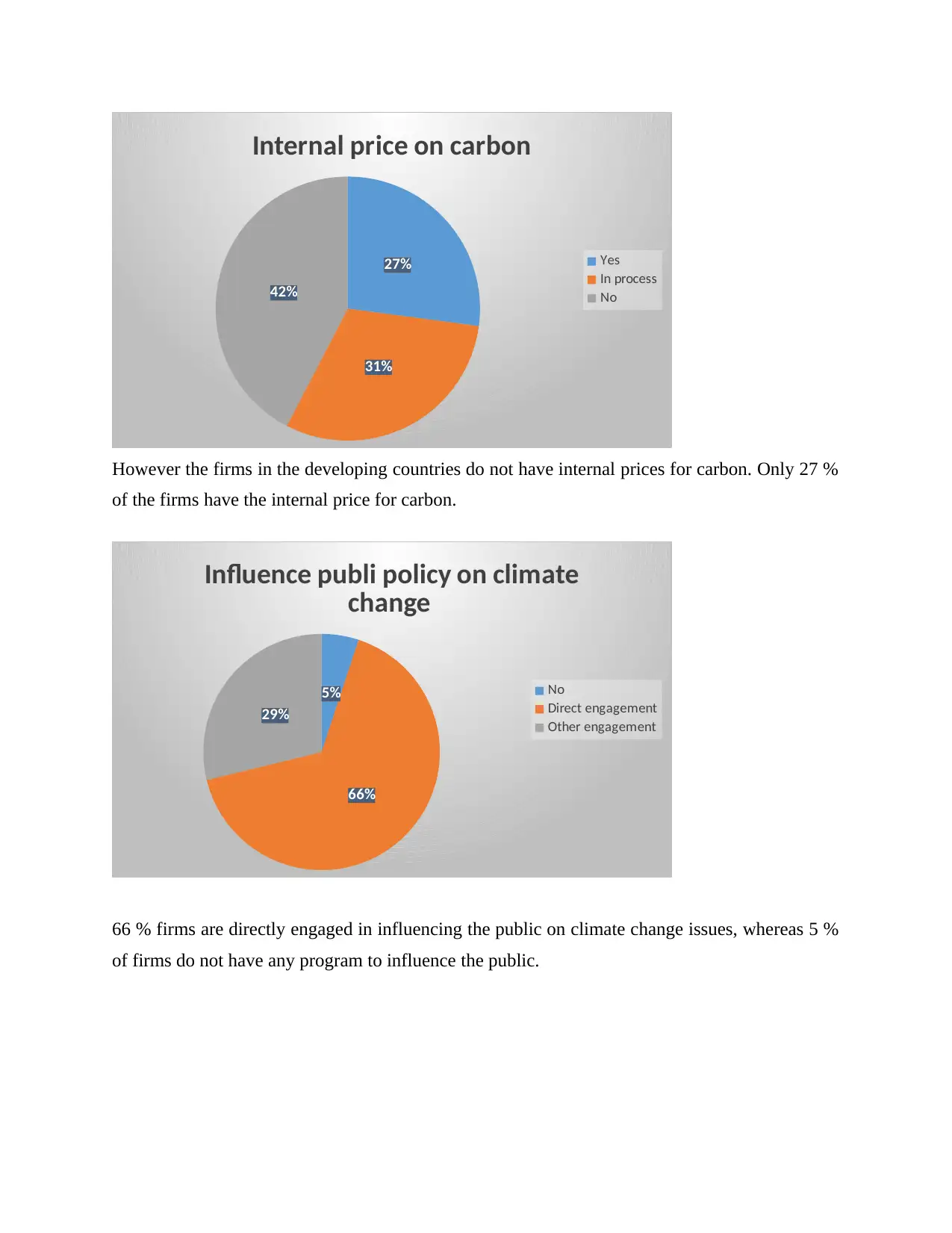
27%
31%
42%
Internal price on carbon
Yes
In process
No
However the firms in the developing countries do not have internal prices for carbon. Only 27 %
of the firms have the internal price for carbon.
5%
66%
29%
Influence publi policy on climate
change
No
Direct engagement
Other engagement
66 % firms are directly engaged in influencing the public on climate change issues, whereas 5 %
of firms do not have any program to influence the public.
31%
42%
Internal price on carbon
Yes
In process
No
However the firms in the developing countries do not have internal prices for carbon. Only 27 %
of the firms have the internal price for carbon.
5%
66%
29%
Influence publi policy on climate
change
No
Direct engagement
Other engagement
66 % firms are directly engaged in influencing the public on climate change issues, whereas 5 %
of firms do not have any program to influence the public.
⊘ This is a preview!⊘
Do you want full access?
Subscribe today to unlock all pages.

Trusted by 1+ million students worldwide

2%
33%
60%
5%
Frequency of monitoring
Every 2 years
annually
half yearly
not defined
Half yearly is the most used frequency for monitoring the carbon emission, whereas annually
monitoring is done by 33 % of the firms in the data set.
59%
37%
3%
Low carbon price
Yes
No
Don't know
Furthermore 59 % of the firms said that their products are low on carbon whereas 37 % of them
said that their products are not low in terms of carbon emission. Rest of the firms were not sure
about their products.
Data analysis (inferential)
Chi square test
33%
60%
5%
Frequency of monitoring
Every 2 years
annually
half yearly
not defined
Half yearly is the most used frequency for monitoring the carbon emission, whereas annually
monitoring is done by 33 % of the firms in the data set.
59%
37%
3%
Low carbon price
Yes
No
Don't know
Furthermore 59 % of the firms said that their products are low on carbon whereas 37 % of them
said that their products are not low in terms of carbon emission. Rest of the firms were not sure
about their products.
Data analysis (inferential)
Chi square test
Paraphrase This Document
Need a fresh take? Get an instant paraphrase of this document with our AI Paraphraser
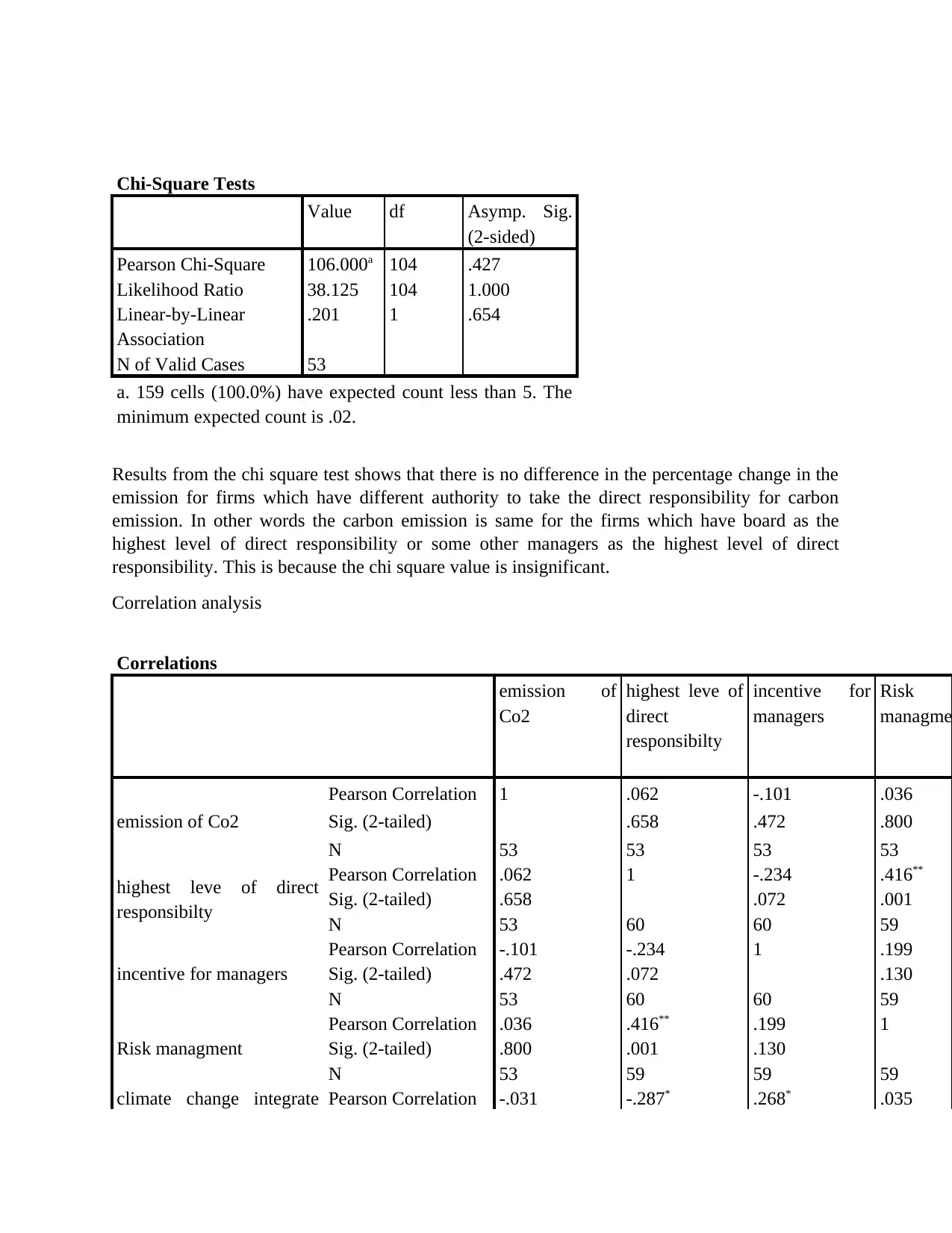
Chi-Square Tests
Value df Asymp. Sig.
(2-sided)
Pearson Chi-Square 106.000a 104 .427
Likelihood Ratio 38.125 104 1.000
Linear-by-Linear
Association
.201 1 .654
N of Valid Cases 53
a. 159 cells (100.0%) have expected count less than 5. The
minimum expected count is .02.
Results from the chi square test shows that there is no difference in the percentage change in the
emission for firms which have different authority to take the direct responsibility for carbon
emission. In other words the carbon emission is same for the firms which have board as the
highest level of direct responsibility or some other managers as the highest level of direct
responsibility. This is because the chi square value is insignificant.
Correlation analysis
Correlations
emission of
Co2
highest leve of
direct
responsibilty
incentive for
managers
Risk
managme
emission of Co2
Pearson Correlation 1 .062 -.101 .036
Sig. (2-tailed) .658 .472 .800
N 53 53 53 53
highest leve of direct
responsibilty
Pearson Correlation .062 1 -.234 .416**
Sig. (2-tailed) .658 .072 .001
N 53 60 60 59
incentive for managers
Pearson Correlation -.101 -.234 1 .199
Sig. (2-tailed) .472 .072 .130
N 53 60 60 59
Risk managment
Pearson Correlation .036 .416** .199 1
Sig. (2-tailed) .800 .001 .130
N 53 59 59 59
climate change integrate Pearson Correlation -.031 -.287* .268* .035
Value df Asymp. Sig.
(2-sided)
Pearson Chi-Square 106.000a 104 .427
Likelihood Ratio 38.125 104 1.000
Linear-by-Linear
Association
.201 1 .654
N of Valid Cases 53
a. 159 cells (100.0%) have expected count less than 5. The
minimum expected count is .02.
Results from the chi square test shows that there is no difference in the percentage change in the
emission for firms which have different authority to take the direct responsibility for carbon
emission. In other words the carbon emission is same for the firms which have board as the
highest level of direct responsibility or some other managers as the highest level of direct
responsibility. This is because the chi square value is insignificant.
Correlation analysis
Correlations
emission of
Co2
highest leve of
direct
responsibilty
incentive for
managers
Risk
managme
emission of Co2
Pearson Correlation 1 .062 -.101 .036
Sig. (2-tailed) .658 .472 .800
N 53 53 53 53
highest leve of direct
responsibilty
Pearson Correlation .062 1 -.234 .416**
Sig. (2-tailed) .658 .072 .001
N 53 60 60 59
incentive for managers
Pearson Correlation -.101 -.234 1 .199
Sig. (2-tailed) .472 .072 .130
N 53 60 60 59
Risk managment
Pearson Correlation .036 .416** .199 1
Sig. (2-tailed) .800 .001 .130
N 53 59 59 59
climate change integrate Pearson Correlation -.031 -.287* .268* .035
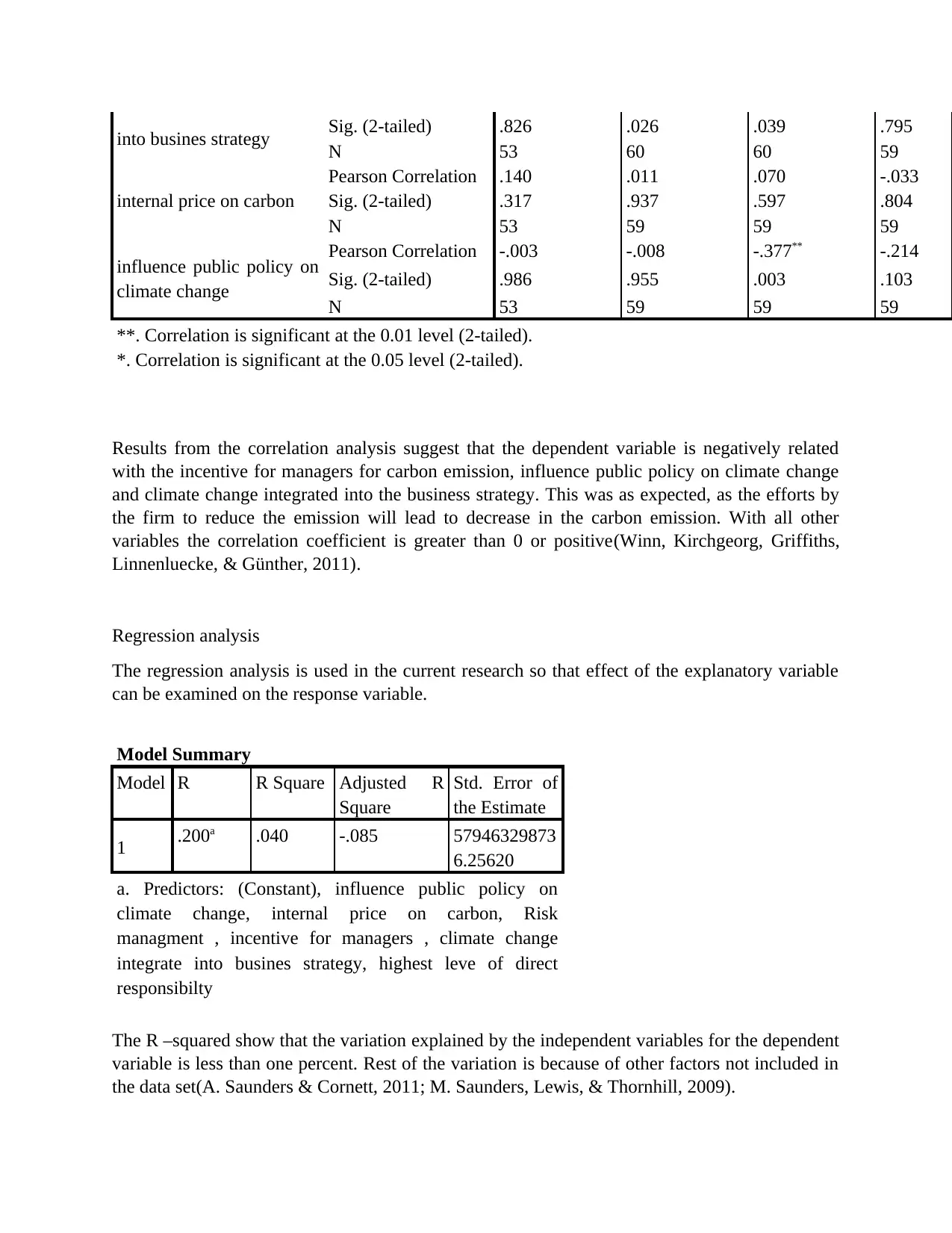
into busines strategy Sig. (2-tailed) .826 .026 .039 .795
N 53 60 60 59
internal price on carbon
Pearson Correlation .140 .011 .070 -.033
Sig. (2-tailed) .317 .937 .597 .804
N 53 59 59 59
influence public policy on
climate change
Pearson Correlation -.003 -.008 -.377** -.214
Sig. (2-tailed) .986 .955 .003 .103
N 53 59 59 59
**. Correlation is significant at the 0.01 level (2-tailed).
*. Correlation is significant at the 0.05 level (2-tailed).
Results from the correlation analysis suggest that the dependent variable is negatively related
with the incentive for managers for carbon emission, influence public policy on climate change
and climate change integrated into the business strategy. This was as expected, as the efforts by
the firm to reduce the emission will lead to decrease in the carbon emission. With all other
variables the correlation coefficient is greater than 0 or positive(Winn, Kirchgeorg, Griffiths,
Linnenluecke, & Günther, 2011).
Regression analysis
The regression analysis is used in the current research so that effect of the explanatory variable
can be examined on the response variable.
Model Summary
Model R R Square Adjusted R
Square
Std. Error of
the Estimate
1 .200a .040 -.085 57946329873
6.25620
a. Predictors: (Constant), influence public policy on
climate change, internal price on carbon, Risk
managment , incentive for managers , climate change
integrate into busines strategy, highest leve of direct
responsibilty
The R –squared show that the variation explained by the independent variables for the dependent
variable is less than one percent. Rest of the variation is because of other factors not included in
the data set(A. Saunders & Cornett, 2011; M. Saunders, Lewis, & Thornhill, 2009).
N 53 60 60 59
internal price on carbon
Pearson Correlation .140 .011 .070 -.033
Sig. (2-tailed) .317 .937 .597 .804
N 53 59 59 59
influence public policy on
climate change
Pearson Correlation -.003 -.008 -.377** -.214
Sig. (2-tailed) .986 .955 .003 .103
N 53 59 59 59
**. Correlation is significant at the 0.01 level (2-tailed).
*. Correlation is significant at the 0.05 level (2-tailed).
Results from the correlation analysis suggest that the dependent variable is negatively related
with the incentive for managers for carbon emission, influence public policy on climate change
and climate change integrated into the business strategy. This was as expected, as the efforts by
the firm to reduce the emission will lead to decrease in the carbon emission. With all other
variables the correlation coefficient is greater than 0 or positive(Winn, Kirchgeorg, Griffiths,
Linnenluecke, & Günther, 2011).
Regression analysis
The regression analysis is used in the current research so that effect of the explanatory variable
can be examined on the response variable.
Model Summary
Model R R Square Adjusted R
Square
Std. Error of
the Estimate
1 .200a .040 -.085 57946329873
6.25620
a. Predictors: (Constant), influence public policy on
climate change, internal price on carbon, Risk
managment , incentive for managers , climate change
integrate into busines strategy, highest leve of direct
responsibilty
The R –squared show that the variation explained by the independent variables for the dependent
variable is less than one percent. Rest of the variation is because of other factors not included in
the data set(A. Saunders & Cornett, 2011; M. Saunders, Lewis, & Thornhill, 2009).
⊘ This is a preview!⊘
Do you want full access?
Subscribe today to unlock all pages.

Trusted by 1+ million students worldwide
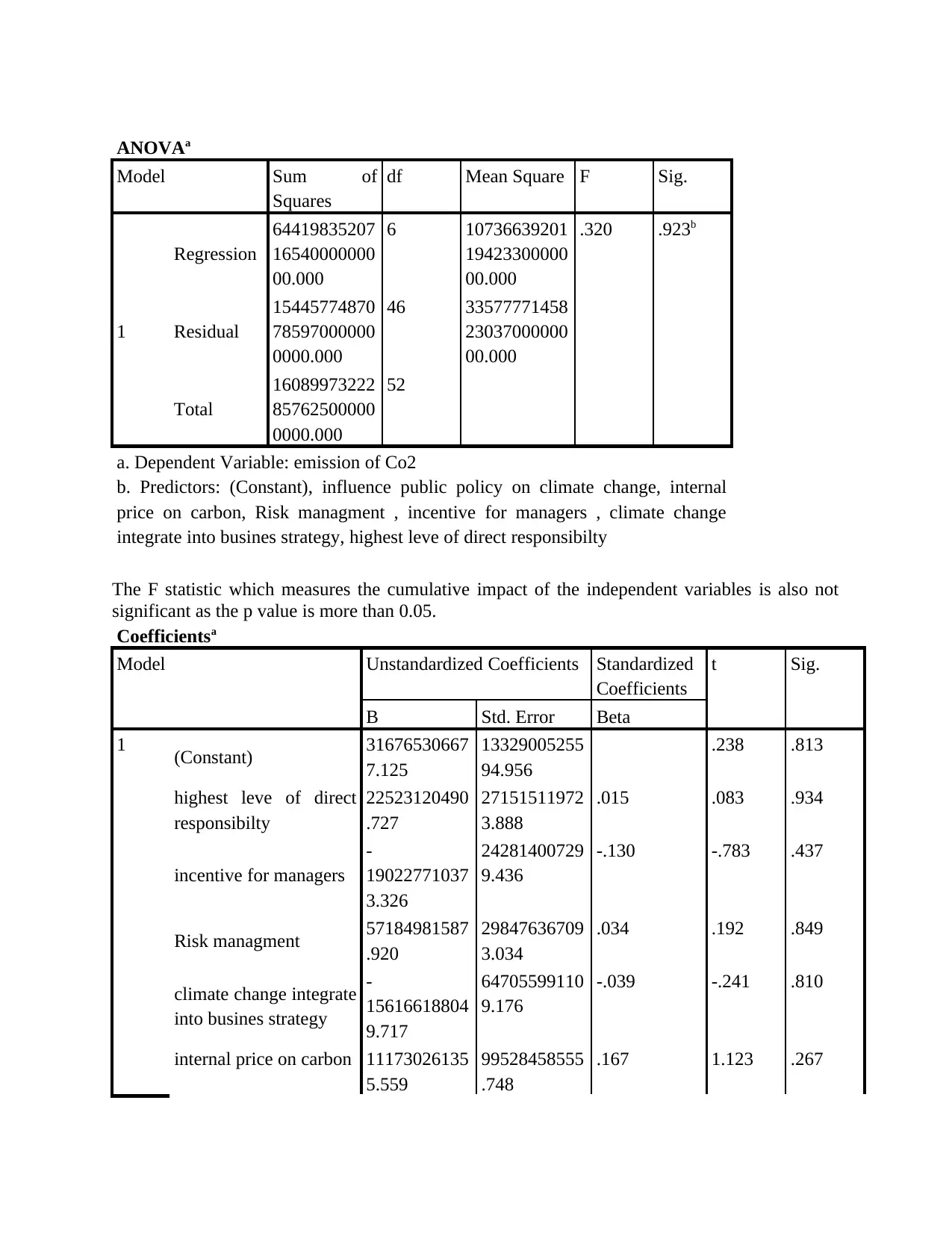
ANOVAa
Model Sum of
Squares
df Mean Square F Sig.
1
Regression
64419835207
16540000000
00.000
6 10736639201
19423300000
00.000
.320 .923b
Residual
15445774870
78597000000
0000.000
46 33577771458
23037000000
00.000
Total
16089973222
85762500000
0000.000
52
a. Dependent Variable: emission of Co2
b. Predictors: (Constant), influence public policy on climate change, internal
price on carbon, Risk managment , incentive for managers , climate change
integrate into busines strategy, highest leve of direct responsibilty
The F statistic which measures the cumulative impact of the independent variables is also not
significant as the p value is more than 0.05.
Coefficientsa
Model Unstandardized Coefficients Standardized
Coefficients
t Sig.
B Std. Error Beta
1 (Constant) 31676530667
7.125
13329005255
94.956
.238 .813
highest leve of direct
responsibilty
22523120490
.727
27151511972
3.888
.015 .083 .934
incentive for managers
-
19022771037
3.326
24281400729
9.436
-.130 -.783 .437
Risk managment 57184981587
.920
29847636709
3.034
.034 .192 .849
climate change integrate
into busines strategy
-
15616618804
9.717
64705599110
9.176
-.039 -.241 .810
internal price on carbon 11173026135
5.559
99528458555
.748
.167 1.123 .267
Model Sum of
Squares
df Mean Square F Sig.
1
Regression
64419835207
16540000000
00.000
6 10736639201
19423300000
00.000
.320 .923b
Residual
15445774870
78597000000
0000.000
46 33577771458
23037000000
00.000
Total
16089973222
85762500000
0000.000
52
a. Dependent Variable: emission of Co2
b. Predictors: (Constant), influence public policy on climate change, internal
price on carbon, Risk managment , incentive for managers , climate change
integrate into busines strategy, highest leve of direct responsibilty
The F statistic which measures the cumulative impact of the independent variables is also not
significant as the p value is more than 0.05.
Coefficientsa
Model Unstandardized Coefficients Standardized
Coefficients
t Sig.
B Std. Error Beta
1 (Constant) 31676530667
7.125
13329005255
94.956
.238 .813
highest leve of direct
responsibilty
22523120490
.727
27151511972
3.888
.015 .083 .934
incentive for managers
-
19022771037
3.326
24281400729
9.436
-.130 -.783 .437
Risk managment 57184981587
.920
29847636709
3.034
.034 .192 .849
climate change integrate
into busines strategy
-
15616618804
9.717
64705599110
9.176
-.039 -.241 .810
internal price on carbon 11173026135
5.559
99528458555
.748
.167 1.123 .267
Paraphrase This Document
Need a fresh take? Get an instant paraphrase of this document with our AI Paraphraser

influence public policy
on climate change
-
66628498947
.867
17855639922
5.969
-.063 -.373 .711
a. Dependent Variable: emission of Co2
In terms of regression coefficient all of the coefficient are positive indicating that all the
independent variable have positive impact on the dependent variable. However the coefficients
are not statistically significant(Guo, 2014; Orsato, 2017).
References
Doytch, N., & Uctum, M. (2011). Globalization and the Environmental Spillovers of sectoral
FDI. New York.
Guo, Y. (2014). Climate Change Disclosure : Determinants and impact. University of Hawai.
Millimet, D. L., & Roy, J. (2011). Three New Empirical Tests of the Pollution Haven Hypothesis
When Environmental Regulation is Endogenous. Bonn.
Orsato, R. J. (2017). Organizational adaptation to climate change: learning to anticipate energy
disruptions. International Journal of Climate Change Strategies and Management, 9(5),
645–665.
Saunders, A., & Cornett, M. M. (2011). Financial Institutions Management: A Risk Management
Approach. The McGrawHillIrwin series in finance insurance and real estate Financial
institutions and markets (Vol. 7th).
Saunders, M., Lewis, P., & Thornhill, A. (2009). Research methods for business students (5th
editio). Harlow: Pearson Education Limited.
Winn, M., Kirchgeorg, M., Griffiths, A., Linnenluecke, M. K., & Günther, E. (2011). Impacts
from climate change on organizations: a conceptual foundation. Business Strategy and the
Environment, 20(3), 157–173.
on climate change
-
66628498947
.867
17855639922
5.969
-.063 -.373 .711
a. Dependent Variable: emission of Co2
In terms of regression coefficient all of the coefficient are positive indicating that all the
independent variable have positive impact on the dependent variable. However the coefficients
are not statistically significant(Guo, 2014; Orsato, 2017).
References
Doytch, N., & Uctum, M. (2011). Globalization and the Environmental Spillovers of sectoral
FDI. New York.
Guo, Y. (2014). Climate Change Disclosure : Determinants and impact. University of Hawai.
Millimet, D. L., & Roy, J. (2011). Three New Empirical Tests of the Pollution Haven Hypothesis
When Environmental Regulation is Endogenous. Bonn.
Orsato, R. J. (2017). Organizational adaptation to climate change: learning to anticipate energy
disruptions. International Journal of Climate Change Strategies and Management, 9(5),
645–665.
Saunders, A., & Cornett, M. M. (2011). Financial Institutions Management: A Risk Management
Approach. The McGrawHillIrwin series in finance insurance and real estate Financial
institutions and markets (Vol. 7th).
Saunders, M., Lewis, P., & Thornhill, A. (2009). Research methods for business students (5th
editio). Harlow: Pearson Education Limited.
Winn, M., Kirchgeorg, M., Griffiths, A., Linnenluecke, M. K., & Günther, E. (2011). Impacts
from climate change on organizations: a conceptual foundation. Business Strategy and the
Environment, 20(3), 157–173.
1 out of 11
Related Documents
Your All-in-One AI-Powered Toolkit for Academic Success.
+13062052269
info@desklib.com
Available 24*7 on WhatsApp / Email
![[object Object]](/_next/static/media/star-bottom.7253800d.svg)
Unlock your academic potential
Copyright © 2020–2025 A2Z Services. All Rights Reserved. Developed and managed by ZUCOL.





